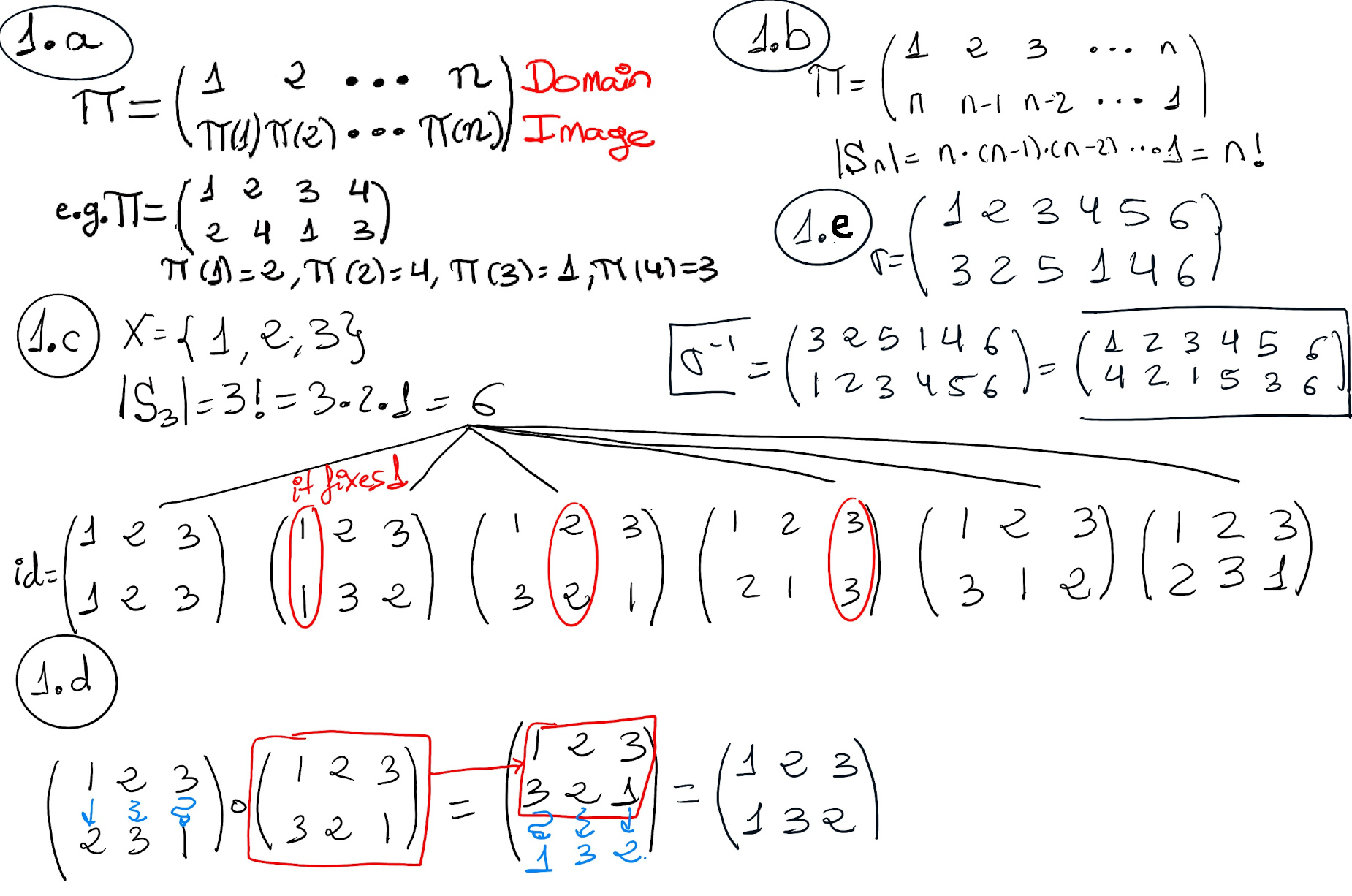
|
 |
 |
|
 |
This is not what it was meant to be, but my crash course in purgatory. I should have known better. I should have been wiser. The more things seems to change, the more they stay the same. Everything just keeps going round and round, people chasing the wind and clutching at clouds and shadows, an insane game of smoke and mirrors. Life is not just a mess mirage in a world ruled by chaos, lies, and deception, but a merry-go-round where we all go around in circles before the final curtains close. And there are never really happy endings, that’s not how the story goes, but love is always new, awesome, and makes the ride worthwhile, Desperate verses III, M. Anawim, #justtothepoint.
Let A be any nonempty set. A permutation of a set is, loosely speaking, an arrangement of its members into a sequence or linear order or if the set is already ordered, a rearrangement of its elements. More formally, a permutation of a set A is a bijection from a set A onto itself (like a shuffle of the elements of the set), that is, a function that is both one-to-one and onto.
All permutations of a set A with n elements form a group under function composition. SA = {f | f: A → A, bijective}. The symmetric group, denoted as SA, is defined as the group of all permutations of a given set.In the particular case when A = {1, 2, 3,···, n} the symmetric group on A is denoted as Sn, the symmetric group of degree n.
Proof:
Proposition: Let X be a finite, non-empty set. Then, |Sx| = |X|!
Proof. Figure 1.b.
Without the loss of generality, we may assume that X = {1, 2, 3, …, n}. The permutations of X -a finite set- are the injective functions of this set to itself. An injection function σ can send 1 to any of the n elements. However, there are n-1 choices for σ(2) -it can be any element of A except σ(1)-, and n-2 choices for σ(3) -it can be any element of A except σ(1) or σ(2)-, and so on. Thus, there are precisely n·(n-1)·(n-2)·…·1 = n! possible injective functions.
Example. Let X = {1, 2, 3}, |SX| = 6 (Figure 1.c.)

A convenient way to write a permutation is to write it in array form and show where each element goes (Figure 1.a.)
σ = $(\begin{smallmatrix}1 & 2 & 3 & 4 & 5 & 6\\ 3 & 2 & 5 & 1 & 4 & 6\end{smallmatrix}\bigr)$
This means that σ(1)=3, σ(2)=2, σ(3)=5, and so on.
Let σ = $(\begin{smallmatrix}1 & 2 & 3 & 4\\ 2 & 3 & 4 & 1\end{smallmatrix}\bigr)$ and η = $(\begin{smallmatrix}1 & 2 & 3 & 4\\ 1 & 3 & 4 & 2 \end{smallmatrix}\bigr)$. We can compose any two permutations since they have the same domain as codomain, and this composite will itself be a permutation, e.g, ση (first apply η and then σ; in other words, we need to read it from right to left ←) = $(\begin{smallmatrix}1 & 2 & 3 & 4\\ 2 & 4 & 1 & 3\end{smallmatrix}\bigr)$, e.g., ση(1)=σ(η(1))=σ(1)=2 (Figure 1.d.).

σ = $(\begin{smallmatrix}1 & 2 & 3 & 4 & 5 & 6\\ 3 & 2 & 5 & 1 & 4 & 6\end{smallmatrix}\bigr)$. Permutations always have inverses since they are bijective. They are easily construct by reflecting horizontally the given permutation and reordering the elements, if necessary, e.g., σ-1 = $(\begin{smallmatrix}1 & 2 & 3 & 4 & 5 & 6\\ 4 & 2 & 1 & 5 & 3 & 6\end{smallmatrix}\bigr)$ (Figure 1.e.)
If two arbitrary sets A and B have the same cardinality, |A| = |B|, then SA ≋ SB. That’s because the structure of the group SA is concerned only with the number of elements in the set A, and not with the elements themselves.
Suppose that there are two sets A and B having the same cardinality, let f: A → B be a one-to-one function mapping from A onto B. We define the function ϕ: SA → SB, ∀σ ∈ SA, then ϕ(σ) is the permutation σ’ ∈ SB such that σ’(f(a)) = f(σ(a)).
Example: A = {1, 2, 3}, B = {a, b, c}, let f: A → B defined as f(1)=a, f(2)=b, f(3)=c. ϕ: SA → SB, $ϕ(\begin{smallmatrix}1 & 2 & 3\\ 2 & 3 & 1\end{smallmatrix}\bigr)=(\begin{smallmatrix}a & b & c\\ b & c & a\end{smallmatrix}\bigr).$
Therefore, we can take {1, 2, …, n} to be a prototype for a finite set A of n elements, e.g., S3. This is also the group D3 of symmetries of an equilateral triangle = { id (identity), two rotations (ρ1, ρ2), and three mirror images (μ1, μ2, μ3)}.
$id = (\begin{smallmatrix}A & B & C\\ A & B & C\end{smallmatrix}) = (\begin{smallmatrix}1 & 2 & 3\\ 1 & 2 & 3\end{smallmatrix}), ρ_1 = (\begin{smallmatrix}A & B & C\\ B & C & A\end{smallmatrix}) = (\begin{smallmatrix}1 & 2 & 3\\ 2 & 3 & 1\end{smallmatrix}), ρ_2 = ρ_1^2 = (\begin{smallmatrix}1 & 2 & 3\\ 3 & 1 & 2\end{smallmatrix}), μ_1 = (\begin{smallmatrix}1 & 2 & 3\\ 1 & 3 & 2\end{smallmatrix}), μ_2 = (\begin{smallmatrix}1 & 2 & 3\\ 2 & 1 & 3\end{smallmatrix}) = ρ_1μ_1, μ_3 = (\begin{smallmatrix}1 & 2 & 3\\ 3 & 2 & 1\end{smallmatrix}) = ρ_1^2μ_1$
Notice that μ1ρ1 = $(\begin{smallmatrix}1 & 2 & 3\\ 3 & 2 & 1\end{smallmatrix})$ ≠ ρ1μ1, so therefore S3 is non Abelian. Futhermore, μ1ρ1 = ρ12μ1 = $(\begin{smallmatrix}1 & 2 & 3\\ 3 & 2 & 1\end{smallmatrix})$, and this relation can be used to compute other products, e.g., μ1ρ12 = (μ1ρ1)ρ1 = (ρ12μ1)ρ1 = ρ12(μ1ρ1) = ρ12(ρ12μ1) = ρ14μ1 = ρ1μ1. 
Definition. A cycle is a permutation which maps a finite set {a1, a2, …, an} by a1 → a2 → … → an → a1, that is, it maps some elements (some subset of elements) to each other in a cyclic fashion, while fixing all others.
More generally, we say that a permutation σ ∈ SX is a cycle of length k if ∃a1, a2, ... ak ∈ X such that a1 → a2 → ... → ak → a1 and it fixes all other elements of X, and it is denoted or written as σ = (a1a2...ak)
A cycle of length 2 is called a transposition. A transposition is a permutation that swaps two elements and leaves everything else fixed. Two cycles are disjoint if they have no common elements between them.
Examples:
Theorem. Every permutation on a finite set can be decomposed, expressed or written as a product of disjoint cycles, that is, no element is moved by both of them, e.g. (135) and (24) are disjoint cycles.
Proof. Let’s induct on the number of elements in the set A.
Case base. Let’s prove the result for a set with just one element. This is trivial, there is only one permutation, the identity, and it is the cycle {a}.
Suppose that a permutation on a set with less than n elements set can be written as a product of disjoint cycles. Let’s take a permutation on a set with n element, that is, σ ∈Sn.
Let m be the order of σ, a1 ∈ A and consider the set Q = {a1, σ(a1), σ2(a1),… σm-1(a1)} being constructed as follows, a2 = σ(a1), a3 = σ(σ(a1)) = σ(a2), and so on, until we arrive at a1 = σm(a1) for some m. We know that m exists because the sequence a1, σ(a1), σ2(a1) must be finite since A is finite.
If Q = A, σ is the cycle and we are done. Otherwise, |A - Q| < n, and by the induction assumption, the permutation σ on A - Q can be written as a product of disjoint cycles, say η1η2…ηk.
And therefore the permutation σ on the whole set A can be written as a product of disjoint cycles, more specifically, as (a1 σ(a1) σ2(a1)… σm-1(a1))η1η2…ηk ∎
Examples:
σ = $(\begin{smallmatrix}1 & 2 & 3 & 4 & 5 & 6 & 7\\ 7 & 6 & 3 & 1 & 2 & 5 & 4\end{smallmatrix})=(174)(265)$ is a product of two disjoint 3-cycles.
σ = (16527348), τ = (152468)(37), στ = (16527348)(152468)(37) = (1286)(457).
Disjoint Cycles Commute. If two cycles move different sets of elements, then their effects are independent and it does not matter in which order they’re applied. More formally, If two pair of cycles σ and η are disjoint, i.e, they do no have entries in common, then ση=ησ.
Proof. Suppose σ and η are disjoint cycles, σ = {a1, a2,…, am} and η = {b1, b2,…, bn}, and {a1, a2,…, am} ∩ {b1, b2,…, bn} = ∅. Let A = {a1, a2,…, am, b1, b2,…, bn, c1, c2,…, cs} where the c’s are the elements left fixed by both σ and η.
Then, ση(i) = ησ(i) ∀i∈A because (ση)(ai) = σ(η(ai)) =[η fixes all ai, 1 ≤ i ≤ m] σ(ai)= ai+1 where am+1=a1. (ησ)(ai) = η(σ(ai)) = η(ai+1) =[η fixes all ai, 1 ≤ i ≤ m] ai+1
A similar argument shows that (ση)(bi) = (ησ)(bi).
Finally, (ση)(ci) = σ(η(ci)) = σ(ci) = ci. (ησ)(ci) = η(σ(ci)) = η(ci) = ci∎
Order of a permutation. The order of a permutation of a finite set A written in disjoint cycle form or representation is the least common multiple of the lengths of the cycles.
Proof:
Case 1. Let |A| = n. If α is a permutation on A and can be represented as a cycle of length n, then it has order n. Therefore, the order of α is equal to the length of its cycle, i.e., |α| = n, and the result holds for this particular case.
Case 2. Let us now suppose that α can be expressed as a product of two disjoint cycles, say α = α1α2 where α1 and α2 are disjoint cycles of lengths t1 and t2 respectively. |α| = t. We need to show that t = lcm (t1, t2).
Recall: lcm(t1, t2) = k ⇒ k = t1s1 = t2s2.
αk = (α1α2)k = [∴ disjoint cycles commute] α1kα2k = α1t1s1α2t2s2 = (α1t1)s1(α2t2)s2 = [A cycle of length n has order n] ee = e ⇒ |α| = t divides k = lcm(t1, t2).
Let αt = (α1α2)t = [∴ disjoint cycles commute] α1tα2t = e ⇒ α1t = α2-t. However, α1 and α2 are disjoint, they share no common symbol ⇒ α1t and α2-t share not common symbol either. If these two cycles are both equal and yet, they share no symbol, it follows that they are both the identity because every symbol that no appears in a permutation is fixed by it, so every symbol in α1t is fixed by α2-t and vice-versa.
Therefore, both t1 and t2 must divide t ⇒ lcm(t1, t2) divides t, too. Then, t = lcm(t1, t2) ∎
lcm (m1, m2,… mr) = k ⇒ k = m1s1 = m2s2 = … = mrsr
αk = (α1α2…αr)k = [∴ disjoint cycles commute] α1kα2k…αrk = α1m1s1α2m2s2…αrmrsr = (α1m1)s1(α2m2)s2…(αrmr)sr= ee…e = e ⇒ |α| = t divides lcm(m1, m2, … mr).
Let αt = (α1α2…αr)t = [∴ disjoint cycles commute] α1tα2t…αrt = e. For the same reasons of two disjoint cycles (that is, α1t does not share any symbols with α2t, α3t …, and αrt, and every symbol that no appears in α2t, …, αrt is fixed by these cycles ⇒ α1t is the identity), α1t = α2t = … = αrt = e ⇒ m1, m2,… mr divide t ⇒ lcm(m1, m2, … mr) divides t ⇒ t = lcm(m1, m2, … mr)∎
Examples:
Definition. A transposition is a permutation which interchanges or swaps two elements and leaves everything else fixed. In other words, a transposition is a cycle of length 2, e.g., (2, 3) is the transposition that swaps 2 and 3 and leaves everything else fixed.